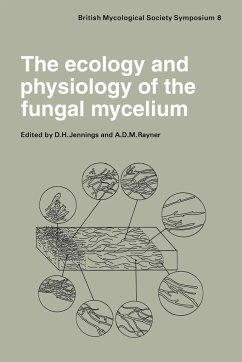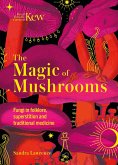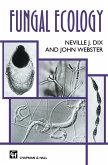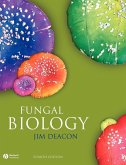The Ecology and Physiology of the Fungal Mycelium
Symposium of the British Mycological Society Held at Bath University 11 15 April 1983
Herausgeber: Jennings, D. H.; Rayner, A. D. M.
The Ecology and Physiology of the Fungal Mycelium
Symposium of the British Mycological Society Held at Bath University 11 15 April 1983
Herausgeber: Jennings, D. H.; Rayner, A. D. M.
- Broschiertes Buch
- Merkliste
- Auf die Merkliste
- Bewerten Bewerten
- Teilen
- Produkt teilen
- Produkterinnerung
- Produkterinnerung
Originally published in 1984, this symposium volume, the first of its kind to deal specifically with the vegetative fungal mycelium, provides a detailed account of the basic body form responsible for the vegetative spread and absorption on nutrients and water.
Andere Kunden interessierten sich auch für
![The Little Book of Fungi The Little Book of Fungi]() Britt A. BunyardThe Little Book of Fungi13,99 €
Britt A. BunyardThe Little Book of Fungi13,99 €![Physiology of Fungal Nutrition Physiology of Fungal Nutrition]() D. H. Jennings (University of Liverpool)Physiology of Fungal Nutrition179,99 €
D. H. Jennings (University of Liverpool)Physiology of Fungal Nutrition179,99 €![The Fungal Community The Fungal Community]() The Fungal Community50,99 €
The Fungal Community50,99 €![Kew - The Magic of Mushrooms Kew - The Magic of Mushrooms]() Sandra LawrenceKew - The Magic of Mushrooms22,99 €
Sandra LawrenceKew - The Magic of Mushrooms22,99 €![Fungal Infections of the Nail and Scalp Fungal Infections of the Nail and Scalp]() Fungal Infections of the Nail and Scalp97,99 €
Fungal Infections of the Nail and Scalp97,99 €![Fungal Ecology Fungal Ecology]() Neville J. DixFungal Ecology101,99 €
Neville J. DixFungal Ecology101,99 €![Fungal Biology 4e Fungal Biology 4e]() J. W. Deacon (University of Edinburgh)Fungal Biology 4e164,99 €
J. W. Deacon (University of Edinburgh)Fungal Biology 4e164,99 €-
-
-
Originally published in 1984, this symposium volume, the first of its kind to deal specifically with the vegetative fungal mycelium, provides a detailed account of the basic body form responsible for the vegetative spread and absorption on nutrients and water.
Hinweis: Dieser Artikel kann nur an eine deutsche Lieferadresse ausgeliefert werden.
Hinweis: Dieser Artikel kann nur an eine deutsche Lieferadresse ausgeliefert werden.
Produktdetails
- Produktdetails
- British Mycological Society Symposia
- Verlag: Cambridge University Press
- Seitenzahl: 582
- Erscheinungstermin: 24. Februar 2011
- Englisch
- Abmessung: 229mm x 152mm x 35mm
- Gewicht: 870g
- ISBN-13: 9780521106269
- ISBN-10: 0521106265
- Artikelnr.: 33610409
- Herstellerkennzeichnung
- Libri GmbH
- Europaallee 1
- 36244 Bad Hersfeld
- gpsr@libri.de
- British Mycological Society Symposia
- Verlag: Cambridge University Press
- Seitenzahl: 582
- Erscheinungstermin: 24. Februar 2011
- Englisch
- Abmessung: 229mm x 152mm x 35mm
- Gewicht: 870g
- ISBN-13: 9780521106269
- ISBN-10: 0521106265
- Artikelnr.: 33610409
- Herstellerkennzeichnung
- Libri GmbH
- Europaallee 1
- 36244 Bad Hersfeld
- gpsr@libri.de
Contributors; Preface; Nomenclature; 1. The fungal mycelium - and
historical perspective P. H. Gregory; 2. Regulation of hyphal branching and
hyphal orientation A. P. J. Trinci; 3. Colony ontogeny in basidiomycetes G.
M. Butler; 4. Hyphal interactions in Schizophyllum commune: the di-mon
mating T. T. Nguyen and D. J. Niderpruem; 5. Hyphal fusion in Coriolus
versicolor R. C. Aylmore and N. K. Todd; 6. The mycelial habit and
secondary metabolite production M. O. Moss; 7. Water flow through mycelia
D. H. Jennings; 8. Morphogenesis of the Serpula lacrimans colony in
relation to its functions in nature S. C. Watkinson; 9. Distribution,
development and functioning of mycelial cord systems of decomposer
basidiomycetes of the deciduous woodland floor W. Thompson; 10. The
structure and function of the vegetative mycelium of mycorrhizal roots D.
J. Read; 11. Autecology and the mycelium of a woodland litter decomposer J.
C. Frankland; 12. The micro-environment of basidiomycete mycelia in
temperate deciduous woodlands L. Boddy; 13. Interrelationships between
vegetative development and basidiocarp initiation M. Raudaskoski and M.
Salonen; 14. Physiology and ecology of rhythmic growth and sporulation in
fungi G. Lysek; 15. Senescence in Podospora anerina and its implication for
genetic engineering K. Esser, U. Kück, U. Stahl and P. Tudzynski; 16. The
mycelial biology of Endothia parasitics. I. nuclear and cytoplasmic genes
that determine morphology and virulence S. L. Anagnostakis; 17. Variation
and heterokaryosis in Rhizoctonia solani N. A. Anderson; 18. Interspecific
mycelial interactions - an overview A. D. M. Rayner and J. F. Webber; 19.
Mycelial development and lectin-carbohydrate interactions in
nematode-trapping fungi B. Nordbring-Hertz; 20. Mycelial interactions and
mitochondrial inheritance in Aspergillus J. H. Croft and R. B. G. Dales;
21. Inter-mycelial recognition systems in Ceratocystis ulmi: their
pysiological properties and ecological importance C. M. Brasier; 22. The
mycelial biology of Endothia parasitica. II. vegetative incompatibility S.
L. Anagnostakis; 23. The biological consequences of individualistic
mycelium A. D. M. Rayner, D. Coates, A. M. Ainsworth, T. J. H. Adams, E. N.
D. Williams and N. K. Todd; Index of generic and specific names; Subject
index.
historical perspective P. H. Gregory; 2. Regulation of hyphal branching and
hyphal orientation A. P. J. Trinci; 3. Colony ontogeny in basidiomycetes G.
M. Butler; 4. Hyphal interactions in Schizophyllum commune: the di-mon
mating T. T. Nguyen and D. J. Niderpruem; 5. Hyphal fusion in Coriolus
versicolor R. C. Aylmore and N. K. Todd; 6. The mycelial habit and
secondary metabolite production M. O. Moss; 7. Water flow through mycelia
D. H. Jennings; 8. Morphogenesis of the Serpula lacrimans colony in
relation to its functions in nature S. C. Watkinson; 9. Distribution,
development and functioning of mycelial cord systems of decomposer
basidiomycetes of the deciduous woodland floor W. Thompson; 10. The
structure and function of the vegetative mycelium of mycorrhizal roots D.
J. Read; 11. Autecology and the mycelium of a woodland litter decomposer J.
C. Frankland; 12. The micro-environment of basidiomycete mycelia in
temperate deciduous woodlands L. Boddy; 13. Interrelationships between
vegetative development and basidiocarp initiation M. Raudaskoski and M.
Salonen; 14. Physiology and ecology of rhythmic growth and sporulation in
fungi G. Lysek; 15. Senescence in Podospora anerina and its implication for
genetic engineering K. Esser, U. Kück, U. Stahl and P. Tudzynski; 16. The
mycelial biology of Endothia parasitics. I. nuclear and cytoplasmic genes
that determine morphology and virulence S. L. Anagnostakis; 17. Variation
and heterokaryosis in Rhizoctonia solani N. A. Anderson; 18. Interspecific
mycelial interactions - an overview A. D. M. Rayner and J. F. Webber; 19.
Mycelial development and lectin-carbohydrate interactions in
nematode-trapping fungi B. Nordbring-Hertz; 20. Mycelial interactions and
mitochondrial inheritance in Aspergillus J. H. Croft and R. B. G. Dales;
21. Inter-mycelial recognition systems in Ceratocystis ulmi: their
pysiological properties and ecological importance C. M. Brasier; 22. The
mycelial biology of Endothia parasitica. II. vegetative incompatibility S.
L. Anagnostakis; 23. The biological consequences of individualistic
mycelium A. D. M. Rayner, D. Coates, A. M. Ainsworth, T. J. H. Adams, E. N.
D. Williams and N. K. Todd; Index of generic and specific names; Subject
index.
Contributors; Preface; Nomenclature; 1. The fungal mycelium - and
historical perspective P. H. Gregory; 2. Regulation of hyphal branching and
hyphal orientation A. P. J. Trinci; 3. Colony ontogeny in basidiomycetes G.
M. Butler; 4. Hyphal interactions in Schizophyllum commune: the di-mon
mating T. T. Nguyen and D. J. Niderpruem; 5. Hyphal fusion in Coriolus
versicolor R. C. Aylmore and N. K. Todd; 6. The mycelial habit and
secondary metabolite production M. O. Moss; 7. Water flow through mycelia
D. H. Jennings; 8. Morphogenesis of the Serpula lacrimans colony in
relation to its functions in nature S. C. Watkinson; 9. Distribution,
development and functioning of mycelial cord systems of decomposer
basidiomycetes of the deciduous woodland floor W. Thompson; 10. The
structure and function of the vegetative mycelium of mycorrhizal roots D.
J. Read; 11. Autecology and the mycelium of a woodland litter decomposer J.
C. Frankland; 12. The micro-environment of basidiomycete mycelia in
temperate deciduous woodlands L. Boddy; 13. Interrelationships between
vegetative development and basidiocarp initiation M. Raudaskoski and M.
Salonen; 14. Physiology and ecology of rhythmic growth and sporulation in
fungi G. Lysek; 15. Senescence in Podospora anerina and its implication for
genetic engineering K. Esser, U. Kück, U. Stahl and P. Tudzynski; 16. The
mycelial biology of Endothia parasitics. I. nuclear and cytoplasmic genes
that determine morphology and virulence S. L. Anagnostakis; 17. Variation
and heterokaryosis in Rhizoctonia solani N. A. Anderson; 18. Interspecific
mycelial interactions - an overview A. D. M. Rayner and J. F. Webber; 19.
Mycelial development and lectin-carbohydrate interactions in
nematode-trapping fungi B. Nordbring-Hertz; 20. Mycelial interactions and
mitochondrial inheritance in Aspergillus J. H. Croft and R. B. G. Dales;
21. Inter-mycelial recognition systems in Ceratocystis ulmi: their
pysiological properties and ecological importance C. M. Brasier; 22. The
mycelial biology of Endothia parasitica. II. vegetative incompatibility S.
L. Anagnostakis; 23. The biological consequences of individualistic
mycelium A. D. M. Rayner, D. Coates, A. M. Ainsworth, T. J. H. Adams, E. N.
D. Williams and N. K. Todd; Index of generic and specific names; Subject
index.
historical perspective P. H. Gregory; 2. Regulation of hyphal branching and
hyphal orientation A. P. J. Trinci; 3. Colony ontogeny in basidiomycetes G.
M. Butler; 4. Hyphal interactions in Schizophyllum commune: the di-mon
mating T. T. Nguyen and D. J. Niderpruem; 5. Hyphal fusion in Coriolus
versicolor R. C. Aylmore and N. K. Todd; 6. The mycelial habit and
secondary metabolite production M. O. Moss; 7. Water flow through mycelia
D. H. Jennings; 8. Morphogenesis of the Serpula lacrimans colony in
relation to its functions in nature S. C. Watkinson; 9. Distribution,
development and functioning of mycelial cord systems of decomposer
basidiomycetes of the deciduous woodland floor W. Thompson; 10. The
structure and function of the vegetative mycelium of mycorrhizal roots D.
J. Read; 11. Autecology and the mycelium of a woodland litter decomposer J.
C. Frankland; 12. The micro-environment of basidiomycete mycelia in
temperate deciduous woodlands L. Boddy; 13. Interrelationships between
vegetative development and basidiocarp initiation M. Raudaskoski and M.
Salonen; 14. Physiology and ecology of rhythmic growth and sporulation in
fungi G. Lysek; 15. Senescence in Podospora anerina and its implication for
genetic engineering K. Esser, U. Kück, U. Stahl and P. Tudzynski; 16. The
mycelial biology of Endothia parasitics. I. nuclear and cytoplasmic genes
that determine morphology and virulence S. L. Anagnostakis; 17. Variation
and heterokaryosis in Rhizoctonia solani N. A. Anderson; 18. Interspecific
mycelial interactions - an overview A. D. M. Rayner and J. F. Webber; 19.
Mycelial development and lectin-carbohydrate interactions in
nematode-trapping fungi B. Nordbring-Hertz; 20. Mycelial interactions and
mitochondrial inheritance in Aspergillus J. H. Croft and R. B. G. Dales;
21. Inter-mycelial recognition systems in Ceratocystis ulmi: their
pysiological properties and ecological importance C. M. Brasier; 22. The
mycelial biology of Endothia parasitica. II. vegetative incompatibility S.
L. Anagnostakis; 23. The biological consequences of individualistic
mycelium A. D. M. Rayner, D. Coates, A. M. Ainsworth, T. J. H. Adams, E. N.
D. Williams and N. K. Todd; Index of generic and specific names; Subject
index.








